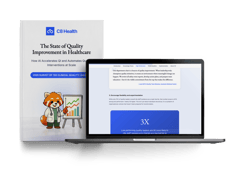
4 Strategies for Improving Patient Satisfaction Scores
Disappointing satisfaction scores can be a thorn in the side of any hospital. Let's be honest: Negative experiences travel faster than positive ones. In today's digital age, a single bad review can deter new patients.
Worse yet, they're less likely to return for future appointments or recommend your services to others. This can have a significant impact on your practice's growth and financial stability.
Fortunately, there are steps you can take to improve the overall experience. By focusing on a few key areas, you can ensure your patients feel valued, informed, and confident in your organization.

Access Clinical Resources: Unite your department's knowledge on any device.
Manage Your Knowledge: Easily create, maintain, and update clinical resources.
Integrate Your Workflows: Deliver content directly to the point-of-care.
Collaborate and Communicate: Share knowledge and communicate across medical institutions.
Analyze Your Data: Track clinician engagement with custom insights.
Key Drivers of Low Patient Satisfaction
Patient satisfaction in hospitals stems from multiple factors, with the attitude of the medical staff being a crucial one. It includes friendliness when answering phones and greeting patients. You can set a strong foundation for a positive experience by prioritizing this attentive approach.
Another key driver is technology. In a McKinsey survey, 79% of respondents said they schedule appointments digitally, and 71% to get prescriptions. This means you can quickly improve patient satisfaction via portals that give them access to their medical notes, labs, and recommendations.
Note: Elderly people often need additional support when using advanced apps. Focusing on accessibility can any issues. For example, you can try keeping the amount of steps to complete a task to a minimum.
While medical staff attitude is undeniably essential, it's difficult to definitively say that it has the most prominent impact on satisfaction scores. For instance, the operating room is less of a personable environment.
In that sense, reception and physicians have a bigger impact than a surgeon. For them, factors like competency, efficiency, and timeliness are more critical.
Improving Patient Satisfaction in Hospitals: Our 5 Strategies
1. Change the Reimbursement Model
Burnout can lead to emotional exhaustion, making it harder for providers to be empathetic and compassionate towards patients. To truly improve satisfaction, hospitals should address the root causes.
For example, the current reimbursement system is often fee-for-service, which incentivizes treating more people in a day even if it's not the best approach in that instance.
You can solve the issue by prioritizing quality over quantity. But shifting to such a model requires effectively and fairly defining and measuring aspects of proper care. There are also concerns about potential downsides, like increased administrative burdens for providers under a new model.
» Implement the best practices for healthcare knowledge management
2. Ease the Administrative Burden
Different healthcare systems may vary in the level of support provided to medical staff, but having it is crucial because it enables providers to focus on improving patient satisfaction scores.
For example, I have a dedicated team for prior authorizations, which alleviates the amount of paperwork. Plus, on days when I'm not in the office, my assistant handles urgent needs and tasks, ensuring care continuity.
Note: Electronic health records (EHRs) and functional portals can also streamline communication between patients and clinicians. They can do this via secure messaging, test results delivery, and appointment scheduling.
You can also leverage the latest technology in healthcare knowledge management in tools like C8 Health, which can create a central repository for all clinical guidance and best practices. The platform eliminates the need for providers to search through scattered resources, saving precious time.
The app also sends push notifications whenever you update protocols. This ensures everyone is on the same page and reduces the risk of someone using outdated information. New technology like this is helping clinicians move from manually and reactively searching for the information they need to proactively serving up the relevant knowledge they'll need based on their schedules, rotations, and procedures.
Our latest case study demonstrates the real-world impact that integrating C8 Health's knowledge management platform had on anesthesiology departments across the US. Download it today to see how making the switch could improve your healthcare organization.
3. Train Your Staff
Providers often need to interact with patients in emotionally charged scenarios. They may involve devastating diagnoses or complicated family dynamics, such as concerns about elderly parents' care.
You should offer staff training on handling these situations and deescalating tensions can improve the overall patient satisfaction score. It should be comprehensive, covering various areas, such as:
- Communication Skills: This equips clinicans to deliver unfortunate information empathetically, actively listen to patient's concerns, and navigate disagreements constructively.
- Emotional Intelligence: Understanding and managing one's own emotions, and recognizing and responding appropriately to patients' worries.
- De-Escalation Techniques: Knowing how to calm those who are more agitated, manage conflict, and create a safe and supportive environment.
- Self-Care Strategies: Helping providers cope with the stress of delivering bad news and maintaining their well-being.
4. Set Clear Guidelines for Patient Behavior
While improving quality care experience is essential, healthcare facilities must also prioritize the safety and well-being of staff. They can achieve it by balancing clear communication of expectations and zero-tolerance policies for abuse.
You should build a culture of respect. Efforts to improve patient satisfaction scores go hand-in-hand with promoting respect between patients and providers. This fosters a positive environment where both parties feel valued and heard.
Financial impact of patient satisfaction
Patient satisfaction scores hold some weight in reimbursement. For example, the Centers for Medicare & Medicaid Services (CMS) runs a program called value-based purchasing (VBP). It gives extra payments to hospitals with high-quality care for covered inpatients, incentivizing constant improvement.
Maximizing revenue is a natural concern so that providers may focus solely on volume. Treating more people in a day translates to added potential billings. This can be a quick way to boost income, primarily if the facility operates on a fee-for-service model.
But, this approach can negatively impact the care experience. Even if patients don't switch clinicians immediately due to frustration, the loyalty erodes in the long run. Fewer referrals and negative online reviews can silently shake a hospital's financial stability.
» Learn how AI and technology innovation integrates into healthcare
Building Lasting Patient Loyalty
Every interaction holds the potential for growth. Reflecting on these experiences, even the challenging ones, is crucial for both personal and professional development.
You should also maintain an open mind and embrace continuous learning. View each visit not as a chance for criticism but as an opportunity to refine your skills and provide even better patient care.
C8 Health can help you in the process by disseminating best practices and the latest medical advancements. Using a detailed text editor, you can easily collaborate and update documents. Plus, you can embed multiple content types with the Smart Format feature.


